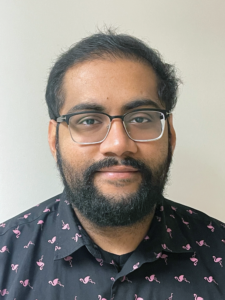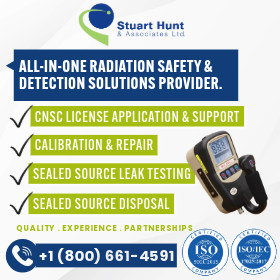2024 Anthony J. MacKay Student Paper Contest: Meet This Year’s Finalists

Each year, the Student and Young Professionals Committee organizes a student paper contest in conjunction with the CRPA annual conference. This contest is open to all students enrolled full time in a Canadian college or university program related to the radiation sciences.
Three finalists are selected to present their work at the conference in a plenary session. The presentations are judged at the end of the session, and the winner is announced during the awards banquet. The winner is presented with the Anthony J. MacKay trophy and receives a $250 cash prize. The winning paper will also be published in the CRPA Bulletin.
All students who enter the contest are given a free one-year membership to the CRPA. Conference registration (including the banquet) and three nights hotel accommodation are provided for all three finalists.
Meet this year’s finalists!
 Meghan Sanderson
Meghan Sanderson
Medical and Biological Physics
McMaster University
Meghan is an undergraduate student in the Medical and Biological Physics program at McMaster University. She completed her co-op term with the McMaster Health Physics Department, where she assisted in the planning and execution of the RDS-112 cyclotron decommissioning project. She has also completed her undergraduate thesis investigating how to mitigate motion from the cardiac cycle in diffusion tensor MR imaging of the brain. In addition to academia, she enjoys getting involved in her community as a medical first responder, as well as being an advocate and mentor for women in STEM.
Tell us a little bit about yourself.
I am a medical and biological physics co-op student at McMaster University. I am passionate about healthcare, and I love travelling. My favourite trip to date was a medical service trip to Peru. In my free time, you can find me teaching line dancing.
Share some background on your submitted work.
During my co-op placement with the McMaster Health Physics Department as a student radiation surveyor, I had the privilege of contributing to a pioneering decommissioning project. I am grateful for my time, and I learned so much working with a multidisciplinary team of engineers, architects, contractors, and the radiation safety team. The project would not have been successful without everyone’s hard work and dedication.
How did you hear about the Anthony J. MacKay Student Paper Contest?
I first heard about the student paper contest when it was recommended to me by my co-op supervisor.
What are you looking forward to most at the conference this June?
I am excited to attend my first CRPA conference, and I look forward to learning about the impactful work of my fellow participants. I am looking forward to sharing my own work and meeting others in the field.
What’s up next for you?
This summer, I’ll be working on brachytherapy research at Princess Margaret Cancer Centre in Toronto. My aspiration is to further explore this field in my future graduate studies, focusing on medical physics.
Read Megan’s abstract: RDS-112 Cyclotron Facility Decommissioning
 Nicholas Somer
Nicholas Somer
PhD in Nuclear Engineering
Ontario Tech University
Nicholas is a PhD candidate at Ontario Tech University. He has a background in physics (UBC) and nuclear engineering (Ontario Tech University). His main area of research is nuclear decommissioning. Nicholas has long-term aspirations to work in the nuclear industry in health physics or engineering roles to support the development of technologies to reduce worker dose.
Tell us a little bit about yourself.
I am a PhD student from Ontario Tech University. My background in physics motivated me to pursue a productive career in the nuclear industry. I went from understanding the industry to wanting to help build and improve it. On the side, I am an avid cornet and trumpet player.
Share some background on your submitted work.
My research focuses on developing advanced methods to capture radionuclide aerosols produced during nuclear decommissioning and dismantlement work. The goal of capture is to reduce dose to the worker and to the environment by capturing the aerosols at the source. While there are feasible technologies to use in the field, we do not yet have an understanding of how much dose they will reduce. As such, we need to model the dose reduction based on the effectiveness of capture devices. This initial model has turned into a branch of my PhD research, in which I hope to better understand the sizing of filtration systems and how I should scale up the capture device that I am currently developing.
How did you hear about the Anthony J. MacKay Student Paper Contest?
I sought some guidance from my university’s radiation safety officer, and he recommended that I submit to this contest.
What are you looking forward to most at the conference this June?
I am a physicist and engineer by training, so radiation protection is something that is somewhat new to me. There are many people here that know a lot more about radiation protection principles, so their feedback could greatly help my work.
What’s up next for you?
I am currently wrapping up my PhD. As my research work has straddled both radiation protection and engineering, I am looking to seek employment in engineering and health physics.
Read Nicholas’ abstract: Estimation of Effects of Filtration and Ventilation on Worker Inhalation Dose from Aerosols During Nuclear Dismantlement
 Shayenthiran (Shayen) Sreetharan
Shayenthiran (Shayen) Sreetharan
PhD in Radiation Sciences
McMaster University (graduated December 2023)
Shayenthiran is the Radiation Safety Specialist and Alternate Radiation Safety Officer for London Health Sciences Centre (LHSC) and St. Joseph’s Health Care London. He supports the radiation safety program for workers at both hospital networks.
He recently graduated with his PhD from the radiation sciences program at McMaster University. He has published a total of 12 peer-reviewed publications, including 5 review publications on radiation topics. He is also a mentee/member of ICRP Task Group 121.
Outside of his professional roles, he is passionate about science communication and education. He has previously held a range of science education positions.
Tell us a little bit about yourself.
My name is Shayen Sreetharan and I am currently working and living in London, Ontario, with my wife. I completed my PhD in 2023 through the Radiation Sciences Graduate Program (“Rad Grad”) at McMaster University in Hamilton, Ontario. My graduate research investigated the effects of ionizing radiation during development in mammalian models. Outside of my graduate research, I am passionate about science education and communication. Within the technically complex field of radiation sciences (with what seems like an endless list of units for measurement of dose or exposure), I believe it is important to be able to explain these concepts in a manner that can be understood by a wide range of audiences.
Share some background on your submitted work.
My submitted work is part of my involvement with the International Commission on Radiological Protection (ICRP) as a mentee/member of ICRP Task Group 121, which is investigating the effects of ionizing radiation exposure in offspring and next generations. My role within the task group is performing a literature review regarding evidence for multi-generational (where the exposure continues into subsequent generations) and trans-generational (where there is a recovery period in later generations) effects in non-human biota.
One advantage of these non-human study models is that shorter generations allow us to investigate generational impacts of radiation exposure, which is difficult to study within humans. I am completing this work under the mentorship of Dr. Christelle Adam-Guillermin, a researcher at Institut de Radioprotection et de Sûreté Nucléaire (IRSN), France’s nuclear regulator. I applied for this mentorship position through an open call on the IRCP website. As this task group’s work aligned well with my graduate research in the field of developmental radiation biology, I was interested in contributing to this unique and fascinating concept of radiation exposure effects that may persist multiple generations following the initial exposure.
How did you hear about the Anthony J. MacKay Student Paper Contest?
I previously submitted an abstract for the student paper contest following a discussion with Dr. Diana Moscu, former CRPA President. Diana highly recommended the student paper contest as an opportunity to present my research as a graduate student.
What are you looking forward to most at the conference this June?
I am most excited to build connections and expand my network with other attendees. My goal is to learn from the other presentations and experts within the Canadian radiation protection community. It will also be my first time visiting Edmonton, and I hope to find time to explore the city!
What’s up next for you?
I am currently working as a radiation safety specialist for two hospital networks in London, Ontario. As I continue to grow in this role, I am looking to get more involved with health physics support for the organization, such as X-ray shielding applications and nuclear medicine room designations. I am also planning to apply for CRPA(R) certification in the future, and I will be working toward that by preparing for the exam and gaining experience in my current radiation protection role. In regards to the ICRP work that I submitted, our task group is continuing to review the literature and working toward a final ICRP publication on the topic.
Read Shayen’s abstract: Ionizing Radiation Exposure Effects Across Multiple Generations in Non-Human Biota
See related articles:
2023 Anthony J. MacKay Student Paper Contest, May 17, 2023
2022 Anthony J. Mackay Student Paper Contest Winners, February 16, 2023
2019 Anthony J. MacKay Student Paper Contest, June 7, 2019
2018 Anthony J. MacKay Student Paper Contest, May 8, 2018
Do you want to read more articles like this?
The Bulletin is published by the Canadian Radiation Protection Association (CRPA). It’s a must-read publication for radiation protection professionals in Canada. The editorial content delivers the insights, information, advice, and valuable solutions that radiation protection professionals need to stay at the forefront of their profession.
Sign up today and we’ll send you an email each time a new edition goes live. In between issues, check back often for updates and new articles.
Don’t miss an issue. Subscribe now!
Subscribe

 Meghan Sanderson
Meghan Sanderson Nicholas Somer
Nicholas Somer Shayenthiran (Shayen) Sreetharan
Shayenthiran (Shayen) Sreetharan

